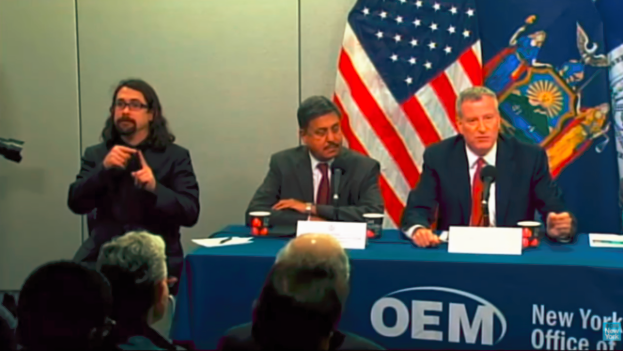
During the Ebola crisis of 2014, an American Sign Language (ASL) interpreter appeared at a televised press conference hosted by Mayor of New York Bill deBlasio. The interpreter’s facial expressions were very animated and a person in the front row could be seen signing to him throughout the event, prompting suspicion among hearing viewers. His performance went viral on Twitter, and a CBS reporter captured the general tone of the response when he tweeted, “Watching @BilldeBlasio #Ebola news conference at repair shop. Most here are convinced his sign language interpreter is faking it.” Other social media users posted screen grabs of the interpreter in unflattering positions and joked that he was “just spelling out Rush lyrics.” The New York Daily News posted a video of “Mayor de Blasio's sign language interpreter's funniest moments.”
In fact, the interpreter, Jonathan Lamberton, is a Deaf man who was hired to function as a Certified Deaf Interpreter (CDI). CDIs are often hired to interpret important messages that will be broadcast to a large Deaf and hard-of-hearing audience that may range widely in their level of ASL comprehension and preferred dialect. CDIs, who typically have ASL as their first language, work in conjunction with hearing interpreters who have studied ASL as their second language. The hearing interpreter signs the speaker’s words to the CDI, who then takes advantage of their native understanding of ASL to interpret the message in the clearest way possible. Both interpreters use facial expressions which would seem ‘exaggerated’ to a hearing viewer because the face is an essential element of signed languages; factors like the position of the eyebrows and the shape of the mouth play a role in grammar and syntax.
Presumably, most people who described the press conference interpreter as ‘hilarious’ or suspected he was exaggerating his expressions for dramatic effect did not have malicious intentions. However, these reactions are symptomatic of the way Deaf culture can be perceived among hearing people. Many Deaf ASL teachers and video bloggers have expressed frustration at the tendency of some hearing people to misrepresent and exoticize ASL. If you log onto Youtube, you’ll find countless videos in which hearing people who have received no formal instruction in sign language perform popular songs “in ASL” or teach ASL vocabulary. However, the signs that are taught are often incorrect, and many hearing ‘song signers’ are unaware that ASL has distinct rules of grammar and syntax, rendering their translations incoherent. It’s difficult to imagine someone with no formal training in a spoken language like Swedish making a video in which they translated each word of an English song individually and then sang them in sequence with no regard for grammar. Even instructional videos on spoken languages tend to be presented by people who have at least taken relevant classes. This double standard implies that some people view ASL as an exciting party trick or a variant of English rather than a legitimate language. It’s not hard to imagine how someone with this view might feel qualified to decide whether a press conference interpreter is faking or exaggerating ASL.
In reality, ASL is a unique, complex language that takes years of study to attain fluency in. It has a grammatical system of its own (which actually has more in common with French than English), and can effectively express any thought that can be articulated through speech. For hearing people with an interest in learning more about the language, the best approach is to seek out content created by Deaf and hard-of-hearing people. For example, people hoping to study ASL online can take advantage of Lifeprint, an instructional website maintained by Dr. Bill Vicars, a Deaf professor of ASL who holds a doctorate in Deaf Studies. There are also Youtube Channels like BYUFanatic, run by Deaf ASL teacher Rob Nielson, and apps like Marlee Signs, which features Marlee Matlin, a Deaf actress. Hearing people who want to learn more about Deaf culture can also check out the amazing content on the Deaf Professional Arts Network, videos created by Deaf vloggers, and countless other examples of creative work produced by the Deaf community.
If you want to take your studies further, seek out ASL lessons in your community. In KW, the Canadian Hearing Society works in conjunction with Conestoga College to offer a certificate program in ASL. As a hearing person, I’ve found these classes incredibly valuable for picking up grammatical elements of the language that are hard to describe in a non-interactive medium. However, whether or not you decide to study ASL yourself, remember that it’s a complex language at the centre of a rich culture. And the next time you see a news story about a ‘hilarious’ interpreter, think critically before you respond.